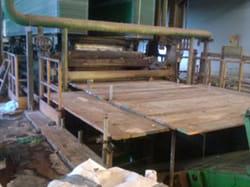Tractor Trolley Double Plate Rims - Uses, Structure
Tractors and their attachments are essential to the agricultural sector. The tractor trolley double plate rim is one of the essential parts. This crucial component guarantees strength and stability, particularly when moving large objects. The significance, composition, and advantages of the tractor trolley double plate rim will all be covered in this article.
What is a Tractor Trolley Double Plate Rim?
One type of specialised wheel component is a tractor trolley twin plate rim. It is intended for tractor trolleys that traverse a variety of terrains while transporting huge goods. Double-plate rims offer more durability than conventional single-plate rims.
They are specially designed to endure harsh environments and tremendous pressure. Even under severe strain, these rims provide a steady and secure ride.
Structure of a Double Plate Rim
Two plates make up the double plate rim. To improve durability and strength, these plates are stacked. Because of its construction, the rim can support large loads without buckling or deforming. The strength of the rim is enhanced by the distinct thickness of each plate.
While the inside portion locks onto the trolley's hub, the outside surface attaches to the tyre. By equally distributing weight, the space between the plates reduces the possibility of rim failure.
Importance of Tractor Trolley Double Plate Rims
When doing heavy-duty agricultural operations, double plate rims are necessary. They make sure the tractor-trolley runs smoothly even when there is a lot of weight. These carts are used by farmers to move equipment, crops, and dirt.
The load's safety may be jeopardised by a weak rim. Because it provides better support, the twin plate rim avoids these problems. Additionally, by lessening tyre wear and tear, these rims help tyres last longer.
Advantages of Using Double Plate Rims
Using a tractor-trolley twin plate rim has several benefits.
● First of all, it is quite durable. Its robust construction reduces the possibility of damage while in use.
● Second, improved load distribution is offered by twin plate rims. This keeps one rim point from experiencing undue tension.
● Thirdly, their rims provide more stability when being transported. The trolley's equilibrium is less affected by the big loads than it would be with single plate rims.
● Lastly, two plate rims are better able to manage uneven surfaces. They offer a more comfortable ride on rocky terrain and uneven farm fields.
Materials Used in Double Plate Rims
The performance of double plate rims is significantly influenced by the materials used in their construction. In most cases, premium steel or alloy is used to make these rims. Because of its durability and capacity to bear high pressure, steel is the material of choice.
Certain rims are made of a treated alloy that is resistant to corrosion and rust. This increases lifespan, particularly in abrasive agricultural settings. The rim's weight is also influenced by the material selection. Materials that are both robust and lightweight can provide the best of both worlds.
How to Maintain a Double Plate Rim?
For a tractor trolley double plate rim to last a long time, proper maintenance is essential. Frequent examinations aid in spotting any wear and tear early on. If the rim is not maintained, it may eventually rust or bend.
Corrosion may be avoided by washing the rim and clearing away any dirt or debris. Smoother functioning is ensured by lubricating the joints between the hub and the rim. The tram should not be overloaded since this might lead to an early failure of the rim.
For agricultural transportation, the tractor trolley double plate rim is an essential part. It is perfect for carrying huge weights because of its strength and longevity. The effectiveness of agricultural activities can be increased by selecting the appropriate double plate rim.
This crucial component's lifespan is further increased by routine maintenance and safety inspections. A two-plate rim is a great investment for any farmer seeking performance and dependability.






Comments